
AI SEO Content Strategy: Full-Funnel Approach in the AI Search Era
Introduction: The Collapse of the Funnel
The marketing funnel, as we know it, is dead. Traditional SEO playbooks are becoming obsolete as AI-powered search fundamentally rewrites how buyers discover, evaluate, and purchase products. Today’s reality: a single ChatGPT prompt can deliver awareness, consideration, and conversion in one seamless interaction—no clicks required.
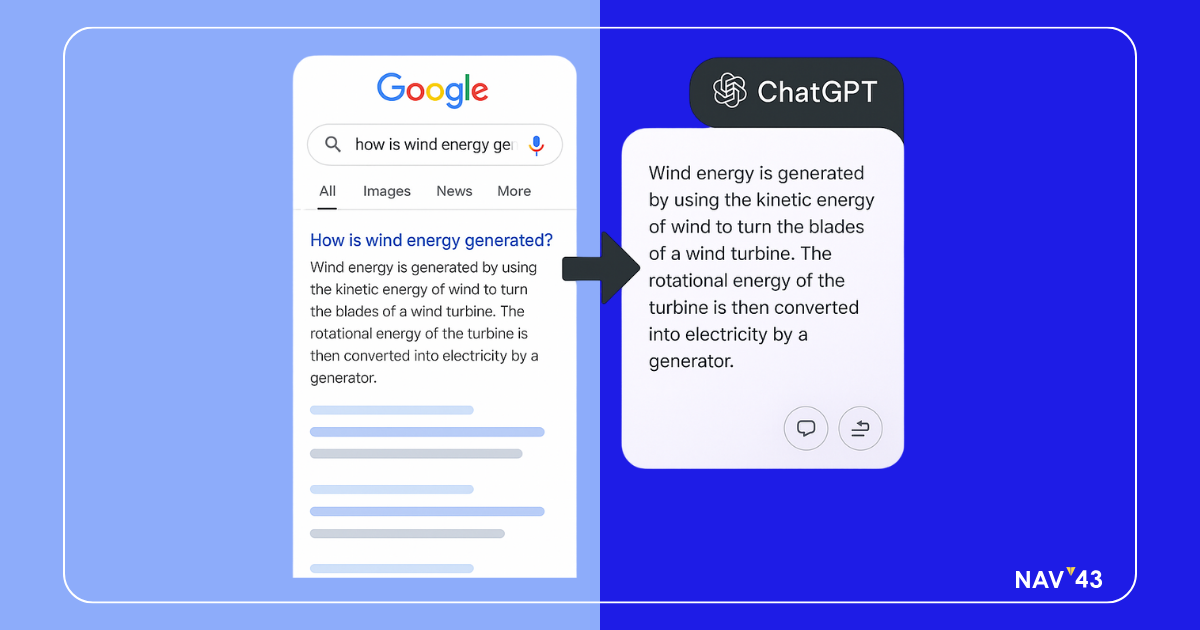
Despite these changes, the seo space is still primarily focused on conventional ranking methods, with most tools and strategies not yet adapted for the new AI and semantic search paradigms.
This shift isn’t theoretical. When 80% of consumers rely on AI answers for roughly 40% of their searches, we’re witnessing the rise of zero-click search at an unprecedented scale. The carefully constructed stages of the collapsed marketing funnel, from SEO-driven awareness to comparison shopping to checkout, are merging into a singular AI-driven conversation.
For businesses clinging to yesterday’s strategies, this represents an existential threat. For those ready to adapt, it’s the opportunity to dominate answer engine optimization and capture revenue in ways traditional SEO never could. This guide reveals exactly how to win in the age of AI search.
What Is AI SEO & Why It Matters Now
AI SEO represents the evolution from optimizing for search engines to optimizing for answer engines. Unlike traditional SEO that focuses on ranking in search results, AI SEO aims to become the authoritative source that ChatGPT, Bing AI, Google SGE, and other generative AI search platforms cite when answering user queries.
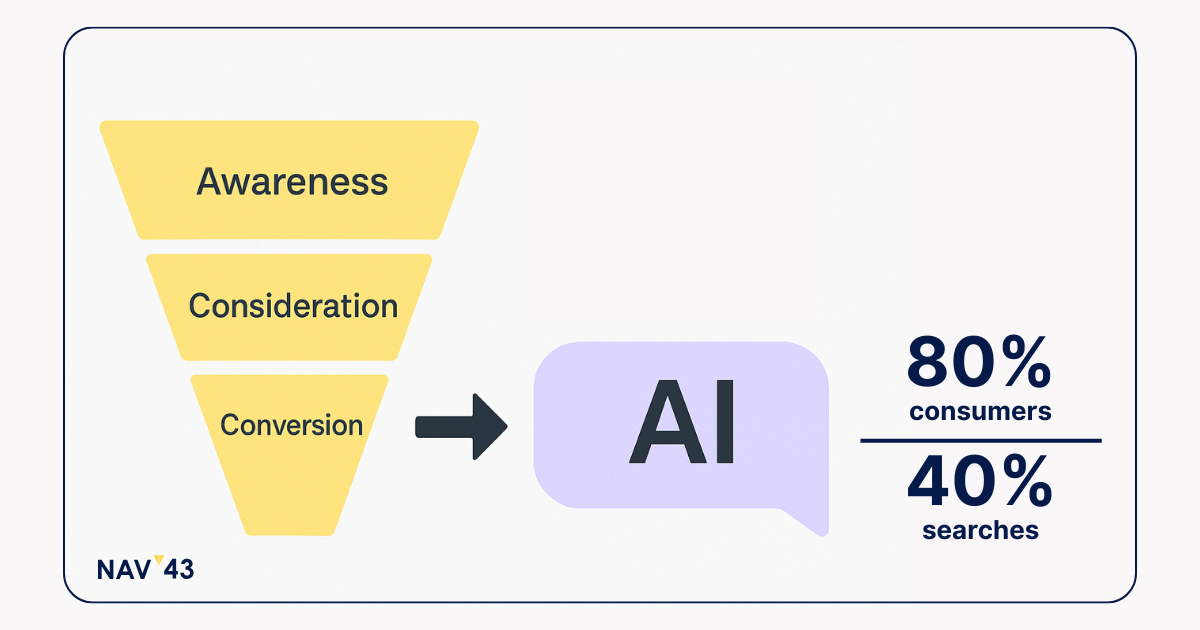
The stakes couldn’t be higher. ChatGPT has already amassed approximately 300 million weekly active users and is projected to hit 1 billion by the end of 2025. That’s billions of queries starting with AI, not traditional search. Meanwhile, Google’s Search Generative Experience (SGE) has been linked to 18-64% drops in organic traffic across tested sites.
Rapid AI adoption is transforming the SEO landscape, with artificial intelligence now central to shaping search rankings, driving content creation, and building user trust.
This isn’t just another algorithm update; it’s a fundamental shift in how information is discovered and consumed. When AI search provides complete answers without requiring users to click through to websites, brands must ensure they’re the ones being quoted. The difference between traditional and AI SEO is stark: one optimizes for clicks, the other for citations.
Early adopters are already seeing the impact. In one documented case, 86% of new visits appeared as “direct” in analytics (up 126% year-over-year), while organic referrals declined 28%, a sign that AI answers were obscuring traditional referrer data. This new reality demands a complete rethinking of the search strategy.
How AI-Powered Search Is Changing User Behaviour
The shift to conversational search is rewriting the entire buyer journey. Instead of clicking through dozens of links across multiple sessions, users now get comprehensive answers—including product recommendations, comparisons, and even checkout options – in a single AI interaction.
Consider this real-world example: A single ChatGPT prompt asking “What’s the best running shoe for flat feet under $120?” can return a top pick, detailed comparisons, inventory checks, and even offer to place the order without opening a browser. The traditional funnel stages of awareness, consideration, and decision are merging into a single conversation.
Adobe Analytics reports that generative AI search traffic to retail grew over 1200% between mid-2024 and early 2025. More significantly, customers who initiate an AI chat tend to convert at significantly higher rates than typical web visitors. This isn’t just changing how people search; it’s transforming how they buy.
AI algorithms now analyze individual user behaviour and preferences to deliver personalized search results, further streamlining the buyer journey and increasing conversion rates.
The zero-click reality is already here. Bain & Company’s research shows that 80% of consumers rely on AI recommendations for approximately 40% of their searches, creating a new paradigm where traditional organic traffic metrics are becoming increasingly irrelevant. Conductor’s SEO team predicts this trend will accelerate: “Zero-click searches will rise. Traffic will go down.” The focus must shift from quantity to quality of engagement.
This behavioural shift means brands can no longer rely on traditional SEO to drive awareness. AI assistants are becoming the primary discovery engine, surfacing answers without links. If your brand isn’t part of those AI-generated responses, you’re essentially invisible to a growing segment of your audience.
E-E-A-T & Authority: The New Ranking Currency
E-E-A-T (Experience, Expertise, Authoritativeness, Trustworthiness) has evolved from a Google ranking factor to the foundation of AI visibility. Large language models don’t just favour sites that align with E-E-A-T—they require it. Without demonstrable authority signals, your content won’t appear in AI-generated answers.
AI systems leverage sophisticated knowledge graphs to determine which sources to trust. Google’s AI Overviews, for instance, cite the most authoritative sources, such as Wikipedia, major media outlets, and recognized industry experts, when summarizing results. ChatGPT shows similar preferences, with analysis revealing clear patterns favouring established, credible sources.
Building E-E-A-T for AI requires more than surface-level optimization. Start with genuine expertise: publish original research, data studies, and thought leadership that others cite. Secure authoritative mentions across trusted platforms, press coverage, industry publications, and even Wikipedia entries. These external validations are integrated into AI knowledge graphs, establishing your brand as a trusted expert source.
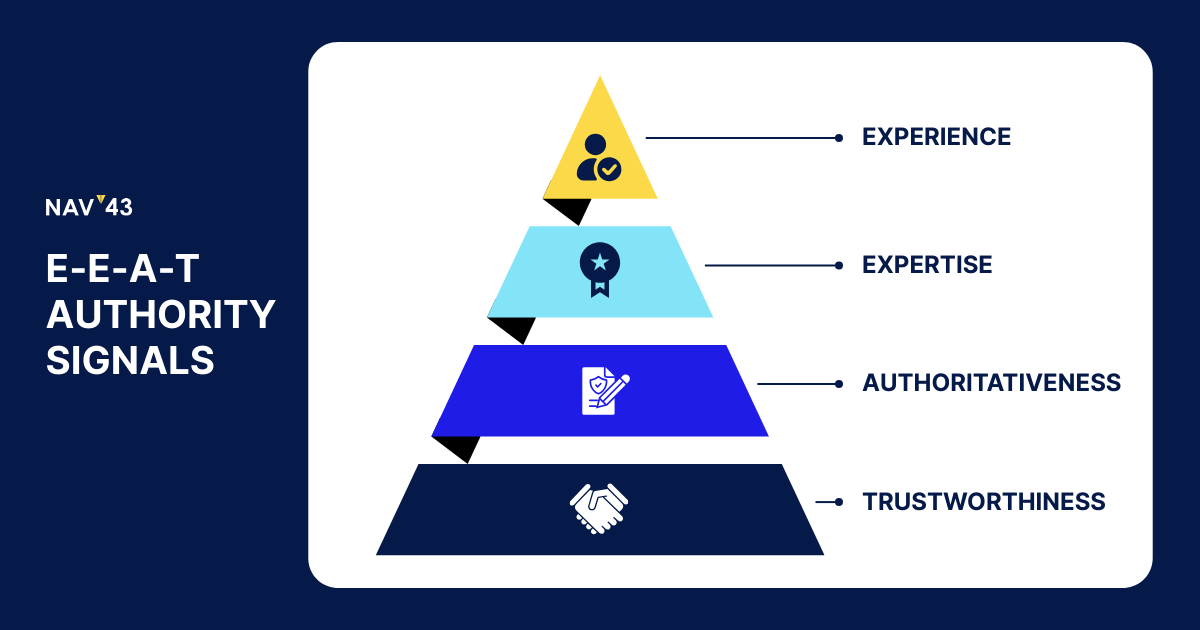
On-page signals matter too. Use real author bylines with verifiable credentials. Include concrete data, citations, and evidence of first-hand experience. Showcase case studies that demonstrate real-world results. Demonstrating semantic relevance in your content helps AI models better understand and trust your expertise, improving your chances of being cited. AI models actively seek these signals of authenticity; they’re trained to distinguish between genuine knowledge and thin content.
The multiplier effect is powerful: once AI systems recognize your authority in a niche, they begin citing you more frequently, which further reinforces your expert status. It’s a virtuous cycle that rewards depth over breadth. A single authoritative resource will outperform dozens of shallow posts when AI is synthesizing answers.
Top-of-Funnel Strategy: Creating Answerable Content for AI Assistants
Traditional top-of-funnel content won’t cut it in the AI age. To appear in AI citations, you need answerable content, resources written explicitly to provide clear, definitive answers that AI can extract and quote verbatim. This starts with creating content that is structured and optimized for AI extraction, ensuring your information is easily accessible and understandable for both users and search engines.
Start by understanding how AI parses content. Language models favour well-structured pages with clear question-answer formats. Instead of burying insights in lengthy narratives, state problems explicitly and immediately provide expert solutions. Think of each page as a comprehensive FAQ where every section directly answers a specific query.
Transform your educational content using this framework: Begin with the exact question users ask (“How do I fix X?” or “What’s the best Y for Z?”). Follow immediately with a concise, quotable answer—ideally 2-3 sentences that AI can lift verbatim. Then expand with supporting evidence, examples, and detailed explanations.
Structure is critical. Use clear H2/H3 hierarchies that mirror natural language queries. Implement FAQ schema to signal question-answer pairs, and consider using AI-powered tools to generate answers for common user questions, further improving SEO. Add numbered lists for processes and comparison tables for alternatives. Every formatting choice should make it easier for AI to extract and attribute your expertise.
Cornerstone content becomes your AI visibility foundation. Content generation can be streamlined with AI-powered tools to produce comprehensive resources. Create definitive guides like “The Complete Guide to [Your Topic] in 2025” or “Everything You Need to Know About [Industry Challenge].” These comprehensive resources should answer every conceivable question within a topic cluster, positioning you as the go-to source for AI systems reference.
Consider creating specialized how-to guides that walk through complex processes step-by-step. AI assistants frequently need to explain procedures, and they prefer sources that break down tasks clearly. Use HowTo schema markup to reinforce the instructional nature of your content, and leverage AI tools to generate answers for step-by-step user queries.
Content Blueprint Checklist
Execute this checklist for every piece of AI-optimized content:
- Open with the exact question in H2 format
- Provide 2-3 sentence answer snippets immediately after
- Structure content with clear subheadings every 150-200 words
- Implement relevant schema markup (FAQ, HowTo, Article)
- Include data tables, bullet lists, and numbered steps
- Add expert quotes and citations from authoritative sources
- Use structured data to mark up key facts and figures
- Create summary boxes with key takeaways
- Ensure mobile-responsive formatting for voice search compatibility
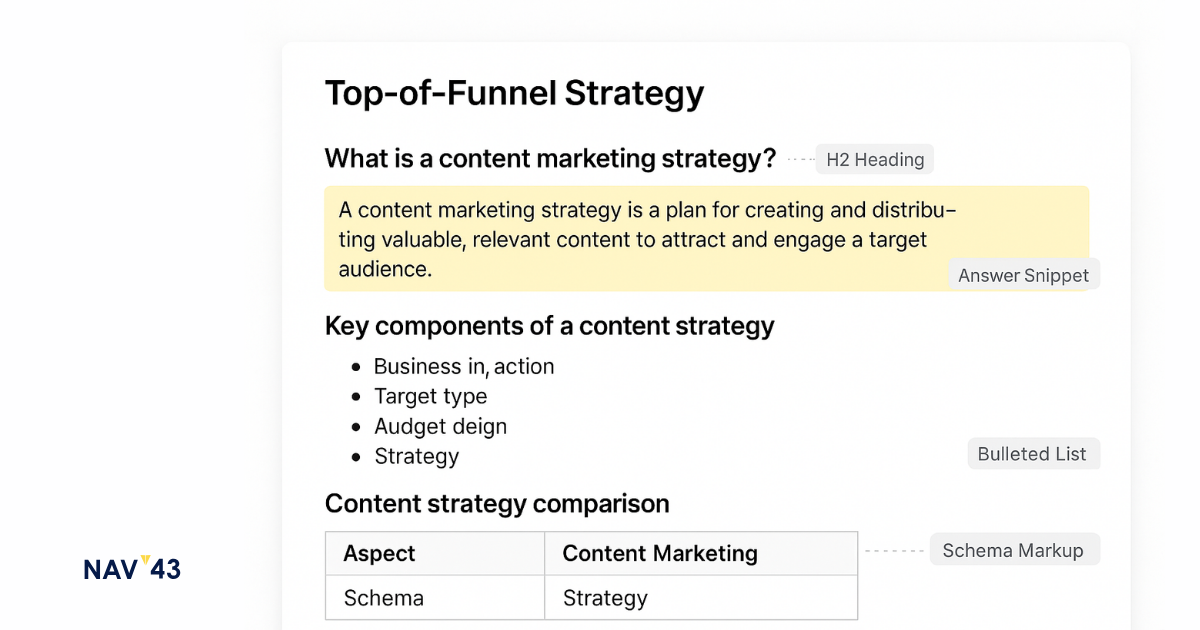
Keyword Research & Optimization for AI Search
In the era of AI-driven search, keyword research and optimization have evolved into sophisticated, data-driven processes that are essential for SEO success. AI-powered tools have transformed how businesses approach keyword research, enabling them to uncover relevant keywords, analyze keyword difficulty, and predict future search trends with remarkable precision.
Modern SEO tools, powered by artificial intelligence, can analyze the vast datasets of search engines to identify the most relevant keywords and phrases for your target audience. These tools go beyond basic keyword suggestions, offering insights into user intent, search volume, and competitive landscape. By leveraging AI-powered SEO tools, businesses can discover untapped keyword opportunities, optimize their content for both traditional and AI search results, and ensure their pages are structured to answer the questions users and AI assistants are asking.
Optimizing for AI search also means preparing for the rise of voice search and conversational queries. AI-powered tools can help you tailor your content to match the natural language patterns users employ when interacting with search engines, thereby increasing your chances of appearing in AI search results. By focusing on relevant keywords, optimizing content structure, and staying attuned to emerging search trends, businesses can drive more relevant traffic to their websites and improve their search engine rankings in an increasingly competitive landscape.
Mid-Funnel Strategy: Comparative & Review Content That AI Loves
AI excels at synthesizing comparative information, making mid-funnel content crucial for visibility during the consideration phase. When users ask “Is Brand A or B better for X?”, your product comparison pages and case study SEO content must be structured for AI extraction.
Start with explicit comparison formats. Create pages titled “X vs Y: Which Is Best for [Specific Use Case]” that directly address everyday buying decisions. Unlike traditional comparison content that often conceals conclusions, AI-optimized comparisons lead with clear recommendations supported by data.
Structure comparison content using pros and cons tables that AI can easily parse. For each option, list 5-7 concrete advantages and disadvantages. Use consistent formatting, as this helps AI understand the relationship between different data points. Include a summary verdict that directly answers which option is better for specific scenarios. On-page optimization is essential here, as it ensures that AI can easily extract and understand the information presented.
Implement review schema across all comparative content. Mark up individual product ratings, aggregate scores, and review counts. AI systems heavily weight structured review data when making recommendations. Include snippets from verified customer reviews, correctly attributed and marked up, and optimize content for both AI and user readability.
Case studies require special attention for AI optimization. Title them as problem-solution stories: “How [Company] Solved [Specific Challenge] with [Solution].” Open with quantified results, then detail the challenge, solution, and implementation. This format aligns with how AI constructs narrative answers about real-world applications.
For e-commerce, transform product pages into answer-driven resources. Add sections explicitly addressing “Who should buy this?” and “Who shouldn’t buy this?” Include compatibility information, use case scenarios, and direct comparisons to alternatives. This turns product pages from sales pitches into informational resources AI can cite.
Ongoing seo optimization is necessary to maintain visibility in AI-driven search environments.
Template: “X vs. Y” Page
Use this versus page structure for AI-optimized comparisons:
- H1: [Product X] vs [Product Y]: Complete Comparison for [Use Case]
- Quick Verdict: 2-3 sentence summary with a clear winner
- Comparison Table: Side-by-side feature grid
- Detailed Analysis: Section for each major difference
- Use Case Recommendations: “Choose X if…” / “Choose Y if…”
- Pricing Breakdown: True cost analysis, including hidden fees
- Expert Opinion: Quote from industry authority
- User Reviews Summary: Aggregated feedback with schema
- Final Recommendation: Clear buying guide conclusion
Bottom-of-Funnel Strategy: Optimizing for Conversational Commerce
The future of conversion is conversational commerce—transactions completed entirely within AI chat interfaces. As voice shopping and chat-based purchases become mainstream, your bottom-funnel strategy must accommodate these new purchase paths.
Shopify ChatGPT integration exemplifies this shift. Users can now ask ChatGPT to add items to the cart and complete checkout without leaving the chat interface. Similar capabilities are emerging across platforms, from WhatsApp commerce to voice assistants handling reorders.
Success in AI checkout requires impeccable product data hygiene. Every SKU requires complete, accurate metadata, including detailed descriptions, multiple high-quality images, comprehensive specifications, real-time inventory status, and competitive pricing information. Enhance your product listings by using ai images to generate high-quality, branded visuals that improve product appeal. AI assistants can only recommend and sell what they can clearly understand.
Structure product information for conversational queries. Instead of feature lists, write natural language descriptions answering “What does this solve?” Include size guides, compatibility charts, and usage instructions in formats AI can extract. Add FAQ sections addressing common pre-purchase questions.
Enable every available conversational commerce channel. If you’re on Shopify, join their ChatGPT sales channel beta immediately. Set up WhatsApp Business shopping, Facebook Messenger commerce, and voice shopping through Alexa and Google Assistant. Leverage AI tools to create and manage social media posts that support product discovery and engagement across these platforms. Each integration expands your AI-accessible inventory.
Reduce friction at every step. Implement one-click reordering, saved payment methods, and simplified guest checkout. When AI assistants encounter complex purchase processes, they’re more likely to abandon the transaction or recommend competitors with smoother experiences.
Technical SEO for AI: Structured Data, APIs & Site Architecture
Technical AI SEO extends beyond traditional crawlability to focus on machine readability and data accessibility. AI systems need structured, semantic data that they can confidently extract and attribute.
Implement comprehensive schema types across your site. Essential markup includes: Article (for content), Product (for e-commerce), Organization (for company info), Person (for authors), Review and AggregateRating (for social proof), FAQ and HowTo (for instructional content), and BreadcrumbList (for site hierarchy).
Use JSON-LD format exclusively—it’s the most reliable for AI parsing. Nest schemas appropriately; for instance, combine Article with Author and Organization schemas to reinforce expertise signals. Validate all markup using Google’s Rich Results Test and Schema.org validator. Advanced SEO software can streamline schema implementation and validation, ensuring your structured data is both accurate and effective.
Consider API accessibility for advanced implementations. While not required, providing structured data via API can improve how AI systems access your content. This is particularly relevant for real-time data like inventory, pricing, or availability that AI assistants need for conversational commerce.
Optimize site architecture for knowledge graph optimization. Create clear topical clusters with hub pages linking to related content. Use consistent internal linking with descriptive anchor text. Implement proper canonical tags to consolidate authority signals. These architectural choices help AI understand your site’s expertise areas.
Monitor crawl efficiency religiously. AI systems, like search engines, have limited crawl budgets. Eliminate duplicate content, fix broken links, and ensure critical pages are easily accessible. Use robots.txt and XML sitemaps strategically to guide AI crawlers to your most authoritative content. Conduct regular site audits to identify and resolve technical SEO issues, and leverage a comprehensive site audit to gain insights into website performance and maintain optimal site health.
An integrated SEO toolkit is invaluable for managing all aspects of technical AI SEO, from site audits and schema implementation to crawl monitoring and knowledge graph optimization.
Measuring Success in a Zero-Click World
Traditional analytics fail in the age of AI attribution. Traditional rank tracking methods are increasingly limited, as they cannot fully capture keyword rankings and visibility in highly personalized, AI-driven environments. When AI answers questions without sending traffic, success metrics must evolve beyond clicks and sessions to capture true influence and revenue impact.
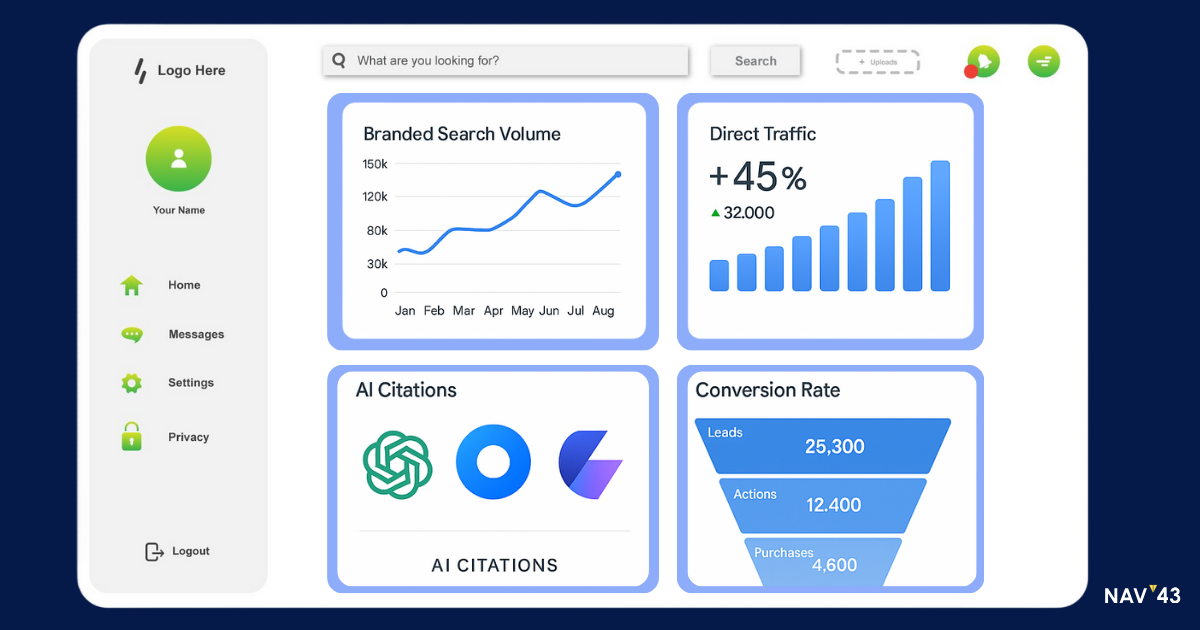
Brand lift metrics become primary KPIs. Monitor branded search volume trends—when AI surfaces your brand as a solution, users often follow up with direct brand searches. A 20% increase in branded queries often indicates successful AI visibility, even if referral traffic appears flat.
Track direct traffic spikes as a proxy for AI influence. In documented cases, sites see direct traffic increase 126% year-over-year as organic search results fall—indicating AI-driven visits that lack referrer data. Sudden direct traffic growth following AI platform rollouts signals attribution leakage from AI sources.
Measure engagement quality over quantity. Focus on: pages per session from direct traffic, conversion rates by traffic source, time on site and scroll depth, and assisted conversions across channels. Monitoring website performance holistically is crucial, as high-intent visitors from AI tend to engage deeply and convert at higher rates than traditional organic traffic.
Implement share of voice tracking for AI platforms. Regularly audit how often your brand appears in AI responses for target queries. Use tools or manual checks to monitor: citation frequency in ChatGPT, Bing Chat, and Google SGE; position in AI-generated lists and recommendations; sentiment of AI mentions; and your website’s visibility across AI platforms.
Create AI-specific conversion tracking. Tag URLs shared in AI responses when possible. Set up dedicated landing pages for AI traffic. Track phone calls and form fills that mention AI assistants. Monitor conversational commerce metrics separately from traditional e-commerce.
8-Week Action Plan to Implement AI SEO
Transform your search strategy with this systematic AI visibility audit and optimization roadmap:
Weeks 1-2: Discovery & Audit
Conduct comprehensive AI visibility audit across ChatGPT, Bing, Google SGE, and Perplexity. Query your top 50 target phrases and document which competitors appear. Identify content gaps where you’re absent from AI responses. Analyze competitor content that AI frequently cites. Assess current E-E-A-T signals and authority markers. Analyze keyword data from tools like Ahrefs, Semrush, and Google Search Console to identify opportunities and refine your list of target keywords.
Weeks 3-4: Content Planning & Structure
Prioritize 10 high-impact topics for content overhaul. For each topic, define target keywords to guide optimization and ensure alignment with search intent. Create detailed content briefs using the answerable content framework. Design comparison templates and FAQ structures. Plan cornerstone content pieces for each major topic cluster. Map schema markup requirements for each content type.
Weeks 5-6: Content Creation & Optimization
Produce definitive guide content with clear answer sections. Follow a structured content creation process that incorporates AI-driven best practices, including keyword research, outline generation, writing, metadata optimization, and publishing. Transform existing content using AI-optimized structures. Implement comprehensive schema markup across all pages. Create comparison pages and case studies in AI-friendly formats. Optimize product pages with conversational commerce in mind.
Weeks 7-8: Technical Implementation & Measurement
Deploy technical SEO improvements and structured data. SEO teams should coordinate and execute the action plan, ensuring all technical and content updates are aligned for maximum impact. Set up AI-specific tracking and attribution systems. Configure conversational commerce channels where applicable. Launch monitoring dashboards for AI visibility metrics. Begin weekly AI citation audits to track progress.
Use this launch checklist for each optimization sprint: Content formatted for AI extraction, Schema markup validated and deployed, E-E-A-T signals enhanced, Technical issues resolved, Tracking systems configured, and Initial AI visibility documented.
Common Pitfalls & How to Avoid Them
Three critical AI SEO mistakes can derail your entire strategy. Here’s how to avoid them:
Keyword Stuffing 2.0: Attempting to game AI with repetitive phrases backfires spectacularly. AI models are trained to detect and discount unnatural language patterns. Instead, write naturally while ensuring key concepts appear in multiple contexts. Focus on semantic richness rather than keyword density. Outdated seo processes and seo practices that rely on keyword stuffing should be replaced with AI-driven methods for better results.
Content Quality Issues: Thin, generic content gets ignored by AI systems. Publishing dozens of shallow articles hoping some stick is futile. AI favors depth and expertise—one comprehensive resource outweighs fifty mediocre posts. Invest in fewer, better pieces that thoroughly address user needs. Even when using AI tools, human writing and editing remain essential for authenticity, trust, and maintaining a unique brand voice.
Data Hygiene problems sabotage AI visibility. Inconsistent NAP (name, address, phone) information, conflicting product data, outdated schema markup, and broken structured data all prevent AI from trusting your content. Maintain meticulous data consistency across all platforms and markup. Leveraging AI for automating repetitive tasks, such as updating schema or checking for data inconsistencies, can help ensure ongoing accuracy and efficiency.
Additional pitfalls include: ignoring mobile optimization (crucial for voice search), neglecting page speed (AI factors in user experience signals), overwhelming content with ads (reduces content accessibility), and failing to update content regularly (AI favors fresh, accurate information).
Future Trends & Predictions
The next wave of voice AI search will reshape SEO once again. As voice-only interactions become primary for many users, content must be optimized for audio delivery. This means shorter sentences, clearer structure, and natural conversation flow.
Autonomous agents represent the next frontier. These AI assistants will handle complex, multi-step tasks independently—researching, comparing, and purchasing without human intervention. Brands must prepare for agent-to-agent commerce where your product data speaks directly to AI buyers.
First-party data will surge in importance as privacy regulations tighten. AI systems will increasingly rely on declared data from brands themselves rather than third-party sources. Companies with rich, self-hosted data repositories will gain significant advantages in AI visibility.
Emerging trends to monitor: Real-time AI optimization where content dynamically adjusts to AI queries, powered by advanced ai algorithms that enable dynamic, context-aware responses; Multimodal search combining text, voice, and visual inputs; Personalized AI responses based on user history and preferences; Blockchain verification for content authenticity and expertise; and API-first content strategies for direct AI integration.
The evolution of search and content strategies is being driven by ai technology, which enhances keyword research, content optimization, and predictive analytics for SEO. Additionally, the rise of ai mode marks a shift from traditional keyword ranking to relevance engineering, where layered reasoning and semantic strategies define the new search paradigm.
Conclusion & Next Steps
The shift to AI-powered search isn’t coming—it’s here. Brands face a clear choice: evolve their AI SEO strategy now or risk losing market share to competitors who capitalize on answer engine dominance.
Success requires more than tactical adjustments. You need a fundamental reimagining of content strategy, technical infrastructure, and success metrics. The brands winning in AI search are those building authoritative, answerable content backed by impeccable E-E-A-T signals.
Your next steps are clear: Conduct an AI visibility audit this week. Identify your top content gaps. Begin transforming one key piece using the frameworks in this guide. Remember: every day you delay is another day your competitors solidify their position in AI responses.
The future belongs to brands that appear in AI conversations. Ensure yours is part of the conversation.
